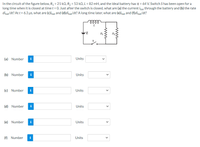In the circuit of the figure below, R1 = 21 kQ, R2 = 53 kN, L = 82 mH, and the ideal battery has 8 = 64 V. Switch S has been open for a long time when it is closed at time t = 0. Just after the switch is closed, what are (a) the current ipat through the battery and (b) the rate dibay/dt? At t = 6.3 µs, what are (c)ipat and (d)dipag/dt? A long time later, what are (e)igat and (f)dipay/dt? EE L. (a) Number i Units (b) Number i Units (c) Number i Units >
In the circuit of the figure below, R1 = 21 kQ, R2 = 53 kN, L = 82 mH, and the ideal battery has 8 = 64 V. Switch S has been open for a long time when it is closed at time t = 0. Just after the switch is closed, what are (a) the current ipat through the battery and (b) the rate dibay/dt? At t = 6.3 µs, what are (c)ipat and (d)dipag/dt? A long time later, what are (e)igat and (f)dipay/dt? EE L. (a) Number i Units (b) Number i Units (c) Number i Units >
Related questions
Question

Transcribed Image Text:In the circuit of the figure below, R1 = 21 kQ, R2 = 53 k0, L = 82 mH, and the ideal battery has 8 = 64 V. Switch S has been open for a
long time when it is closed at time t = 0. Just after the switch is closed, what are (a) the current ipat through the battery and (b) the rate
dipat dt? Att = 6.3 µs, what are (c)ipat and (d)dipa/dt? A long time later, what are (e)ipat and (f)dipat/dt?
lell
L.
R1
Ra
(a) Number
i
Units
(b) Number
i
Units
(c) Number
i
Units
(d) Number
i
Units
(e) Number
i
Units
(f) Number
Units
>
>
>
>
www
Expert Solution
This question has been solved!
Explore an expertly crafted, step-by-step solution for a thorough understanding of key concepts.
Step by step
Solved in 2 steps with 1 images

Follow-up Questions
Read through expert solutions to related follow-up questions below.
Follow-up Question
Please answer parts d, e, and f.

Transcribed Image Text:In the circuit of the figure below, R1 = 21 kQ, R2 = 53 k0, L = 82 mH, and the ideal battery has 8 = 64 V. Switch S has been open for a
long time when it is closed at time t = 0. Just after the switch is closed, what are (a) the current ipat through the battery and (b) the rate
dipat dt? Att = 6.3 µs, what are (c)ipat and (d)dipa/dt? A long time later, what are (e)ipat and (f)dipat/dt?
lell
L.
R1
Ra
(a) Number
i
Units
(b) Number
i
Units
(c) Number
i
Units
(d) Number
i
Units
(e) Number
i
Units
(f) Number
Units
>
>
>
>
www
Solution